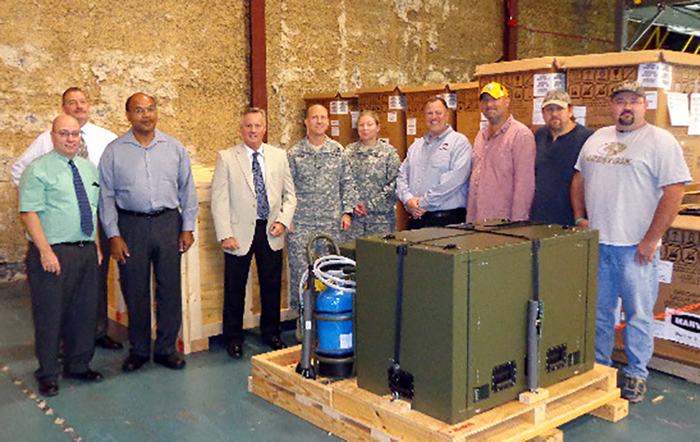Army Begins Fielding New Medical Steam Sterilizer

The Army will begin fielding a new water-efficient vacuum steam sterilizer for combat support hospitals that only uses 10 gallons of water to process up to 100 loads of sterilized medical instruments.
The fielding of the new sterilizer model P2131 Automated Field Steam Sterilizer will retire the model 2151 field sterilizer that has been in use throughout the Army since the late 1960s. The 2151, also fondly called "Bertha," may be the Army's oldest medical device still in use.
The U.S. Army Medical Materiel Agency leaders accepted the first five model P2131 sterilizers Sept. 28, which were delivered to a maintenance depot in Tobyhanna, Pennsylvania.
"The medical equipment we sterilize has become more complex, so we needed something that was more sophisticated and compliant with modern standards," said Patricia Dubill, a biomedical engineer at the USAMMA Medical Devices Program Management Office and Integrated Process Team Chair.
Pre-surgical sterilization procedures have been used since the late 1800s, when it was realized the process greatly decreased post-surgical infection rates and improved overall survival rates.
Medical instrument steam sterilizers consist of a pressure chamber that processes pre-treated medical items with high-pressure saturated steam that kills any infectious materials that may be present. The P2131 sterilizer is a pre and post vacuum sterilizer that enables proper conditioning of the load prior to the exposure phase.
Dubill explained that combat support hospitals in the field have different requirements for steam sterilizers than other medical treatment facilities. In the field, they may have limited availability of power, water and personnel, and sometimes the medical equipment used in these locations has to operate under extreme temperatures, humidity, and altitude. The P2131 not only has a water recovery system that allows it to use 90 percent less water than "Bertha" but it also has a portable water softener system that substantially reduces mineral buildup on heating elements. The P2131 is just as sturdy as "Bertha" yet weighs a little less, runs a faster sterilization cycle, and is fully automated. Leaders also expect the P2131 to save money, reducing Total Lifecycle Costs by 30-40 percent.
The P2131 is cleared by the Food and Drug Administration. The device also meets the safety requirements of the American Society of Mechanical Engineers, which sets the code for boiler and pressure vessel devices.
"The successful testing, selection, and procurement of this device highlights USAMRMC's continued commitment to partnerships with businesses who can deliver innovative medical military-relevant solutions to support the Warfighter," said Dr. Kenneth Bertram, USAMRMC Principal Assistant for Acquisition.
The first few P2131 sterilizers will be placed at the Army Medical Department Center and School so that technicians can train on them. USAMMA biomedical equipment specialist Lamar Reese said the adjustment to the P2131 should be a smooth one, from an operational and maintenance standpoint.
"The new design incorporates some of the features of the 2151, aka 'Bertha,' so it will be an easy transition," said Reese. "It's very modern yet it is still really easy to use."
Reese added the P2131 is also Army green -- just like "Bertha."














